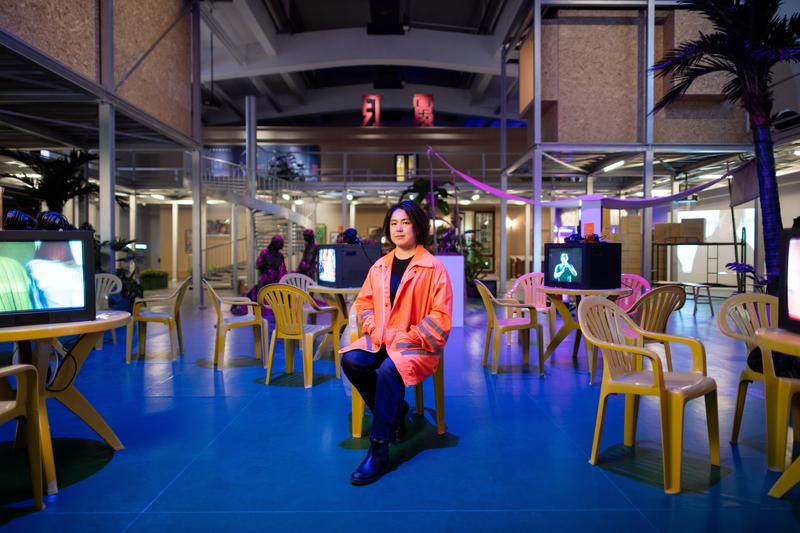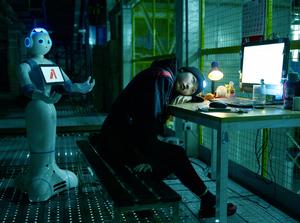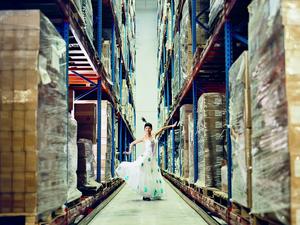Artist uses universal language to tell intriguing stories of everyday life, Deng Zhangyu reports.
 Multimedia artist Cao Fei sits at the Beijing exhibition hall of her retrospective show, where dozens of films, photos, sculptures and virtual reality works are displayed. (PHOTO PROVIDED TO CHINA DAILY)
Multimedia artist Cao Fei sits at the Beijing exhibition hall of her retrospective show, where dozens of films, photos, sculptures and virtual reality works are displayed. (PHOTO PROVIDED TO CHINA DAILY)
Walking through a two-story exhibition hall presenting multimedia artist Cao Fei's retrospective show is like time travel, where visitors can experience the changes that happened in China over the past 20 years.
In one area of the UCCA Center for Contemporary Art in Beijing, visitors watch people dancing to music popular in the 1990s. In another area, they can see factory workers playing the guitar or practicing tai chi at a busy assembly line. And if they turn around, they can see a robot following a girl around an automated warehouse.
Regarded as one of the most prominent contemporary artists in China, Cao is holding the exhibition Staging the Era, a retrospective of her career.
The spacious exhibition hall is filled with dozens of films, photos, installations and virtual reality works to create an immersive experience for visitors. The 43-year-old artist hopes to attract people from all walks of life if possible, as they are usually the subjects in Cao's lens.
"I hope people such as laborers, taxi drivers, and those who have never visited a museum come to my show. The show is a story about them," says the Beijing-based artist.
In the past few years, Cao has frequently presented her works on the international stage, going to renowned institutions such as the Tate Modern in London, Centre Pompidou in Paris and the Guggenheim Museum in New York. Domestic and international media outlets have described Cao as an artist who depicts China's social shifts and individuals affected by the changes.
"I never positioned myself as a Chinese storyteller. I just use the universal language to illustrate the stories of individuals," Cao explains. "The language can be hip-hop, humor or anything that allows visitors to understand without difficulty."
 Highlights of Cao Fei's show include Asia One. (PHOTO PROVIDED TO CHINA DAILY)
Highlights of Cao Fei's show include Asia One. (PHOTO PROVIDED TO CHINA DAILY)
The artist once invited residents of Guangzhou, New York and Fukuoka to perform hip-hop dance for her Hip-Hop series from 2003 to 2006.
Philip Tinari, curator of Cao's show, is also a keen observer of her work.
"She stands out as an example of a Chinese artist working in a global context," he says.
Cao, who is also a mother of two children, spends as much time as possible in her studio to capture social shifts.
"Instead of an existing studio, mine is at the public space of society," she says.
Factory utopia
Born in the port city Guangzhou in Guangdong province, Cao is drawn to her birthplace, a manufacturing center greatly contributing to China's economic boom. The large number of factories in Guangzhou and nearby cities helped the country to be the "world's factory" in the 2000s. Factories and workers thus became constant subjects in Cao's works.
From 2005 to 2006, Cao spent half a year working at a light bulb factory in Foshan, a city 40 kilometers away from her hometown, and shot her signature film Whose Utopia.
She asked 500 workers questions like what they were interested in and which songs they would listen to before starting work. She then selected 30 workers and taught them how to create artworks using the products they produced.
Cao found that after their busy shifts on the assembly lines, some workers will play the guitar, practice tai chi and dance in their spare time. A young woman in her ballet leotard with angel wings dancing in the workshop. A man practicing tai chi as bulbs move along an assembly line behind. These are scenes that she had included in Whose Utopia.
"I love to combine documentary and drama in my works," Cao says.
Whose Utopia documented life at a typical factory in China at a time when the country rose as the world's factory. Cao also wanted to create an art fantasy with the film.
 Telling a futuristic love story in an automated warehouse, Whose Utopia. (PHOTO PROVIDED TO CHINA DAILY)
Telling a futuristic love story in an automated warehouse, Whose Utopia. (PHOTO PROVIDED TO CHINA DAILY)
Ten years later, Cao set her eyes on factories again. This time, she noticed the rapid technological development in China and shot her fictional film Asia One on a futuristic love story in an automated warehouse Asia No 1 built by giant online retailer JD. It was then known as the biggest warehouse in Asia with an AI system.
Paired with the film is a documentary 11.11 also produced by Cao, depicting the busy logistics chain and delivery network during the annual Double 11 shopping festival.
"I'm keen on social shifts. I always capture the changes before they happen and create works on it," Cao says.
From 2007 to 2012, Cao dived into the virtual world and created a virtual city online, resulting in her RMB City series, a pioneering work of internet art. She incorporated virtual reality and augmented reality into many of her works from 2016, such as the art car for BMW and her sci-fi film Nova.
Cao attributes such quick shifts in sensitivity to her habit of reading the news every day. She says it is a habit influenced by her birthplace, which is home to many high-quality media groups in China.
Be it the factories or new technologies used in her works, Cao's interest always lies in the individuals behind them.
In her films lasting from several minutes to a few hours, various people such as cosplayers, delivery men and students confused about their future, can be subjects in front of her camera.
 Depicting workers in a light bulb factory and a sci-fi film Nova. (PHOTO PROVIDED TO CHINA DAILY)
Depicting workers in a light bulb factory and a sci-fi film Nova. (PHOTO PROVIDED TO CHINA DAILY)
People under lens
In her 2005 film Milkman, Cao invited Jian Weiming, a Guangzhou vendor working in the food markets, to play the role of a milkman, whose life intertwines with his dreams. Jian sings for customers when they buy his food. Milkman gave Jian the opportunity to perform for customers and share his stories.
When Cao shot Whose Utopia in a bulb factory, a girl named Lin Ailin performed a peacock dance in her delicate dress in a warehouse. The photo of Lin dancing is often used as a promotional shot for Cao's shows overseas.
"The photo of Lin had been on the banner in Fifth Avenue in New York when my show was staged there. Nobody knew who this Chinese girl was," Cao says.
One day, Lin contacted Cao after seeing herself in Cao's work at an art museum. She told Cao that she had set up her own company in the education industry, and was no longer a factory girl.
Lin began working at the bulb factory at the age of 16 to support her family. After working with Cao, she was eager to see the world outside the factory. She then quit the job and went to school. Now, she is an entrepreneur.
"I never thought that my work would enlighten the dreams of others. Lin's case was like a miracle for me. Put it another way, her story is the typical Chinese dream," Cao says.
The artist's fascination with those less well-off is influenced by Hong Kong movies and local television series of the last century, both of which often concentrated on the marginalized.
"When I was little, my friends were children from families of ship factory workers, cooks and cleaners," Cao says.
As her artist father worked on sculptures, Cao has learned art since she was a child. Her hometown's opening-up to the world also allowed her to assimilate different cultures across the world as she was growing up. Cao began filming videos when she was a teenager.
She dreamed of becoming a filmmaker when she was studying at the Guangzhou Academy of Fine Arts. However, her first film Imbalance 257 focusing on graduates in 1999 gained her international recognition at a show in Spain, leading her to begin an art career.
"When I produce a film, I'm not influenced by the market. I can use all kinds of art mediums to provide comprehensive and immersive works for the audience," says Cao on her choice to become an artist instead of a filmmaker.
In her latest project HX, Cao built a space to showcase the history of a vanishing community in Beijing, where the first computer in China was produced. The project includes historical material, films, books, installations, and VR and AR works.
"I've done works to capture the current shifts and imagine the future," she says. "It's time to look backward into history."
Contact the writer at dengzhangyu@chinadaily.com.cn


